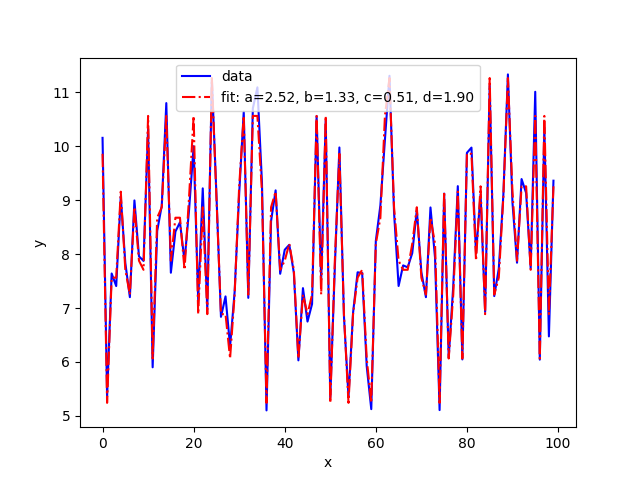python使用curve_fit拟合任意分布
1 2 3 4 5 6 7 8 9 10 11 12 13 14 15 16 17 18 19 20 21 22 23 24 25 26 27 28 29 30 31 32 33 | import matplotlib.pyplot as pltfrom scipy.optimize import curve_fitimport numpy as npdef func(x, a, b, c): # 拟合的方程 return a * np.exp(-b * x) + cdef get_data(): xdata: np.ndarray = np.linspace(0, 4, 50) # x值 y = func(xdata, 2.5, 1.3, 0.5) rng = np.random.default_rng() y_noise = 0.2 * rng.normal(size=xdata.size) ydata: np.ndarray = y + y_noise # y值 return xdata, ydataif __name__ == '__main__': x_value, y_value = get_data() popt, pcov = curve_fit(func, x_value, y_value) # 绘图 plt.plot(x_value, y_value, 'b-', label='data') plt.plot(x_value, func(x_value, *popt), 'r-', label='fit: a=%5.3f, b=%5.3f, c=%5.3f' % tuple(popt)) # 给拟合参数加一个限定范围:0 <= a <= 2.5, 0 <= b <= 1 and 0 <= c <= 0.4 popt_2, pcov_2 = curve_fit(func, x_value, y_value, bounds=([0, 0, 0], [2.5, 1., 0.4])) plt.plot(x_value, func(x_value, *popt_2), 'g--', label='fit: a=%5.3f, b=%5.3f, c=%5.3f' % tuple(popt_2)) plt.xlabel('x') plt.ylabel('y') plt.legend() plt.show() |

2.
1 2 3 4 5 6 7 8 9 10 11 12 13 14 15 16 17 18 19 20 21 22 23 | def func(x, a, b, c, d): # 拟合的方程 return a*x[:,0]+b*x[:,1]-c*x[:,0]*x[:,1]+ddef get_data(): xdata: np.ndarray = np.random.randint(1,5,size=(100,2)) # x值 y = func(xdata, 2.5, 1.3, 0.5,2) y_noise = 0.2 * np.random.normal(size=xdata.shape[0]) ydata = y + y_noise # y值 return xdata, ydataif __name__ == '__main__': x_value, y_value = get_data() popt, pcov = curve_fit(func, x_value, y_value) # 绘图 plt.plot(y_value, 'b-', label='data') plt.plot(func(x_value, *popt), 'r-.', label='fit: a=%4.2f, b=%4.2f, c=%4.2f, d=%4.2f' % tuple(popt)) plt.xlabel('x') plt.ylabel('y') plt.legend() plt.show() |





【推荐】国内首个AI IDE,深度理解中文开发场景,立即下载体验Trae
【推荐】编程新体验,更懂你的AI,立即体验豆包MarsCode编程助手
【推荐】抖音旗下AI助手豆包,你的智能百科全书,全免费不限次数
【推荐】轻量又高性能的 SSH 工具 IShell:AI 加持,快人一步
· 震惊!C++程序真的从main开始吗?99%的程序员都答错了
· winform 绘制太阳,地球,月球 运作规律
· 【硬核科普】Trae如何「偷看」你的代码?零基础破解AI编程运行原理
· 上周热点回顾(3.3-3.9)
· 超详细:普通电脑也行Windows部署deepseek R1训练数据并当服务器共享给他人